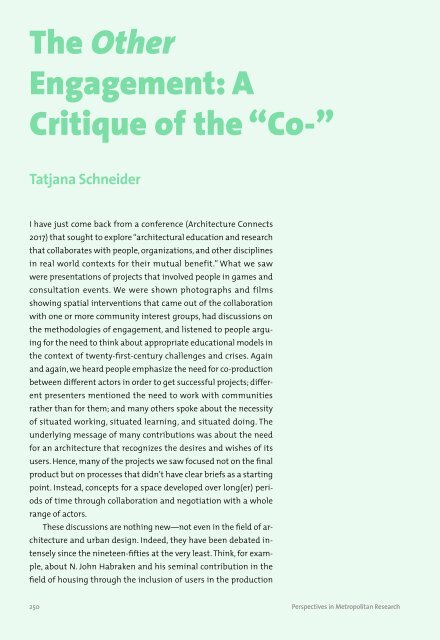Perspectives in Metropolitan Research 5: New Urban Professions – A Journey through Practice and Theory
ISBN 978-3-86859-515-4 https://www.jovis.de/de/buecher/perspectives-in-metropolitan-research/product/new_urban_professions_a_journey_through_practice_and_theory.html
ISBN 978-3-86859-515-4
https://www.jovis.de/de/buecher/perspectives-in-metropolitan-research/product/new_urban_professions_a_journey_through_practice_and_theory.html
Create successful ePaper yourself
Turn your PDF publications into a flip-book with our unique Google optimized e-Paper software.
The Other<br />
Engagement: A<br />
Critique of the “Co-”<br />
Tatjana Schneider<br />
I have just come back from a conference (Architecture Connects<br />
2017) that sought to explore “architectural education <strong>and</strong> research<br />
that collaborates with people, organizations, <strong>and</strong> other discipl<strong>in</strong>es<br />
<strong>in</strong> real world contexts for their mutual benefit.” What we saw<br />
were presentations of projects that <strong>in</strong>volved people <strong>in</strong> games <strong>and</strong><br />
consultation events. We were shown photographs <strong>and</strong> films<br />
show<strong>in</strong>g spatial <strong>in</strong>terventions that came out of the collaboration<br />
with one or more community <strong>in</strong>terest groups, had discussions on<br />
the methodologies of engagement, <strong>and</strong> listened to people argu<strong>in</strong>g<br />
for the need to th<strong>in</strong>k about appropriate educational models <strong>in</strong><br />
the context of twenty-first-century challenges <strong>and</strong> crises. Aga<strong>in</strong><br />
<strong>and</strong> aga<strong>in</strong>, we heard people emphasize the need for co-production<br />
between different actors <strong>in</strong> order to get successful projects; different<br />
presenters mentioned the need to work with communities<br />
rather than for them; <strong>and</strong> many others spoke about the necessity<br />
of situated work<strong>in</strong>g, situated learn<strong>in</strong>g, <strong>and</strong> situated do<strong>in</strong>g. The<br />
underly<strong>in</strong>g message of many contributions was about the need<br />
for an architecture that recognizes the desires <strong>and</strong> wishes of its<br />
users. Hence, many of the projects we saw focused not on the f<strong>in</strong>al<br />
product but on processes that didn’t have clear briefs as a start<strong>in</strong>g<br />
po<strong>in</strong>t. Instead, concepts for a space developed over long(er) periods<br />
of time <strong>through</strong> collaboration <strong>and</strong> negotiation with a whole<br />
range of actors.<br />
These discussions are noth<strong>in</strong>g new—not even <strong>in</strong> the field of architecture<br />
<strong>and</strong> urban design. Indeed, they have been debated <strong>in</strong>tensely<br />
s<strong>in</strong>ce the n<strong>in</strong>eteen-fifties at the very least. Th<strong>in</strong>k, for example,<br />
about N. John Habraken <strong>and</strong> his sem<strong>in</strong>al contribution <strong>in</strong> the<br />
field of hous<strong>in</strong>g <strong>through</strong> the <strong>in</strong>clusion of users <strong>in</strong> the production<br />
250 <strong>Perspectives</strong> <strong>in</strong> <strong>Metropolitan</strong> <strong>Research</strong>


















